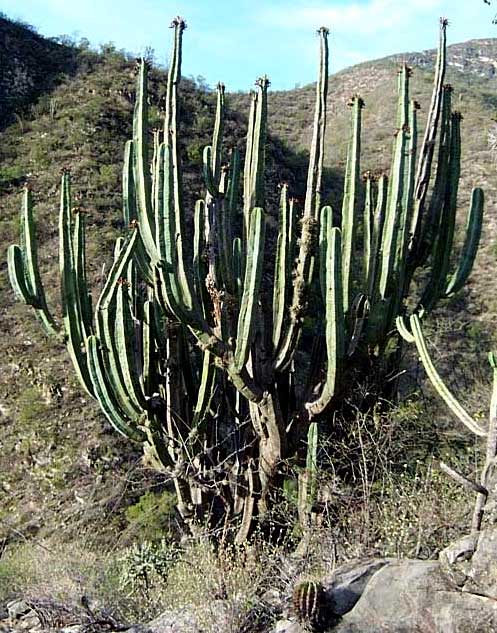Excerpts from Jim Conrad's
Naturalist Newsletter
from the April 14, 2007 Newsletter issued from Sierra Gorda Biosphere Reserve, QUERÉTARO, MÉXICO
ORGAN PIPE CACTUSES FLOWERING
One mental image some people have of village life in Mexico consists of the little rancho with a living fence composed of leg-thick, pole-straight cacti. A cactus species often providing those poles is the Central Mexico Organ Pipe, or Órgano, PACHYCEREUS MARGINATUS. Sometimes you really do see living fences like that, and they're pretty impressive, and can be effective. The species is flowering now, as you can see below:

In that picture the cactus's small flowers are mostly clustered at the tips of its long, vertical branches, though you can see that some branches are floriferous below. This species is so common around here that a lot of people don't respect it at all. Typically any Órgano within reach of the road has been so machete- hacked in random places that it's grotesquely deformed. A big, thick stem easily penetrated by a sharp machete is just too much of a target.
Our Central Mexico Organ Pipe is a different species from the one featured in Organ Pipe National Forest in southwestern Arizona. That's Stenocereus thurberi, which you can see belongs to a different genus -- Stenocereus, not Pachycereus. At first glance species in the two genera look very much allike, because of their similar sizes and similarly branching stems, but in plant classification much more weight is given to flower and fruit anatomy than to vegetative parts.
Our Pachycereus marginatus was originally endemic to three or four central-Mexican states -- with Querétaro being one of them -- but now it's planted in many places as an ornamental and a fence maker. One reason it's planted so widely is that it can be propagated easily with stem cuttings, plus it's a fast grower -- up to three feet a year. The one in the picture, a wild one, is about twelve feet tall.